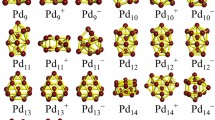Abstract
Topological analyses of the electron density on N-benzoyl-L-pheylalanine and its palladium(II) complexes are carried out using the quantum theory of atoms in molecules (QTAIM) at the M06/6-31G(d) theoretical level. The topological parameters derived from the Bader theory are also analyzed; these are characteristics of Pd bond critical points and ring critical points. The calculated structural parameters are the highest occupied molecular orbital energy (E HOMO), the lowest unoccupied molecular orbital energy (E LUMO), the hardness (η), the softness (S), the absolute electronegativity (χ), the electrophilicity index (ω), and the fractions of electrons transferred (ΔN) from ethylenediamine, 2,2′-bipyridine and 1,10-phenanthroline complexes to N-benzoyl-L-pheylalanine. The numerous correlations and dependences between the energy terms of the symmetry adapted perturbation theory approach, geometrical, topological, and energy parameters are detected and described.
Similar content being viewed by others
References
M. A. Fuertes, C. Alonso, and J. M. Pérez, Chem. Rev., 103, 645 (2003).
W. Dempke, W. Voigt, A. Grothey, et al., Anticancer Drugs, 11, 225 (2000).
D. Wang and S. J. Lippard, Nat. Rev. Drug Discovery, 4, 307 (2005).
S. Ray, R. Mohan, J. K. Singh, et al., J. Am. Chem. Soc., 129, 15042 (2007).
J. Ruiz, J. Lorenzo, and C. Vicente, Inorg. Chem., 47, 6990 (2008).
E. J. Gao, M. C. Zhu, Y. Huang, et al., Eur. J. Med. Chem., 45, 1034 (2010).
L. W. Wang, S. Y. Liu, J. J. Wang, et al., Synth. React. Inorg., Met.-Org., Nano-Met. Chem., 44 (2014).
A. Matilla, J. Tercero, J. Niclós-Gutiérrez, et al., J. Inorg. Biochem., 55, 235 (1994).
P. C. Bruijnincx and P. J. Sadler, Curr. Opin. Chem. Biol., 12, 197 (2008).
M. Fuertes, J. Castilla, C. Alonso, et al., Curr. Med. Chem., 10, 257 (2003).
R. F. W. Bader, T. S. Slee, D. Cremer, et al., J. Am. Chem. Soc., 105, 5061 (1983).
R. G. Parr and R. G. P. W. Yang, Density-Functional Theory of Atoms and Molecules, Oxford, UK (1989).
R. G. Parr, S. R. Gadre, and L. J. Bartolotti, Proc. Natl. Acad. Sci. USA., 76, 2522 (1979).
M. Frisch, G. Trucks, H. Schlegel, et al., Gaussian 03, Wallingford, CT (2004).
B. Jeziorski, R. Moszynski, and K. Szalewicz, Chem. Rev., 94, 1887 (1994).
H. J. Werner and P. J. Knowles, MOLPRO suite of programs, version 2012.
A. Ranganathan, G. Kulkarni, and C. Rao, J. Phys. Chem. A, 107, 6073 (2003).
T.-H. Tang, E. Deretey, S. K. Jensen, et al., Eur. Phys. J. D, 37, 217 (2006).
P. M. Dominiak, E. Grech, G. Barr, et al., Chem.–Eur. J., 9, 963 (2003).
R. G. Parr and W. Yang, J. Am. Chem. Soc., 106, 4049 (1984).
P. Geerlings, F. De Proft, and W. Langenaeker, Chem. Rev., 103, 1793 (2003).
R. G. Parr, L. V. Szentpaly, and S. Liu, J. Am. Chem. Soc., 121, 1922 (1999).
R. G. Pearson, J. Am. Chem. Soc., 85, 3533 (1963).
A. Lesar and I. Milošev, Chem. Phys. Lett., 483, 198 (2009).
S. Martinez, Mater. Chem. Phys., 77, 97 (2003).
R. G. Pearson, Inorg. Chem., 27, 734 (1988).
J. Padmanabhan, R. Parthasarathi, V. Subramanian, et al., J. Phys. Chem. A, 111, 1358 (2007).
K. Senthilkumar, M. Ramaswamy, and P. Kolandaivel, Int. J. Quantum Chem., 81, 4 (2001).
Author information
Authors and Affiliations
Corresponding author
Additional information
The text was submitted by the authors in English.
Zhurnal Strukturnoi Khimii, Vol. 58, No. 3, pp. 499-505, March-April, 2017.
Original Russian Text © 2017 L. Zeidabadinejad, M. Dehestani, S. Pourestarabadi.
Rights and permissions
About this article
Cite this article
Zeidabadinejad, L., Dehestani, M. & Pourestarabadi, S. On the chemical bonding features in palladium containing compounds: A combined QTAIM/DFT topological analysis. J Struct Chem 58, 471–478 (2017). https://doi.org/10.1134/S0022476617030076
Received:
Revised:
Published:
Issue Date:
DOI: https://doi.org/10.1134/S0022476617030076




